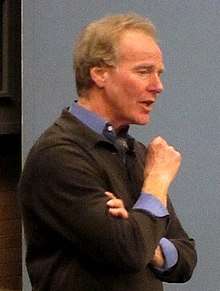A learning organization is the business term given to a organization that facilitates the learning of its members and continuously transforms itself. The concept was coined through the work and research of Peter Senge and his colleagues.

- Peter Senge, 1990.
Quotes
- Quotes are arranged alphabetically by author
A - F
- Learning can be defined as occurring under two conditions. First, learning occurs when an organisation achieves what it intended; that is, there is a match between its design for action and the actual outcome. Second, learning occurs when a mismatch between intention and outcome is identified and corrected; that is, a mismatch is turned into a match.... Single-loop learning occurs when matches are created, or when mismatches are corrected by changing actions. Double-loop learning occurs when mismatches are corrected by first examining and altering the governing variables and then the actions.
- Chris Argyris (1982) as cited in: "Chris Argyris: The Manager's Academic" in Business (2003). p. 965
G - L
- Once a company has adapted to a new environment, it is no longer the organization it used to be; it has evolved. That is the essence of learning.
- Arie de Geus, The Living Company, 1997
- Peter Senge (1990), Fritjof Capra (1996), Peter Checkland (1999), and other researchers have transferred systems thinking principles and theories into practice by applying them to real-world organizational- wide issues, thus encouraging the creation and development of learning organizations.
- Cyndy Jones (2006) "Is your information at risk?" The review of business information systems, Vol 10 (2), p. 7.
M - R
S - Z
- A learning organization is an] organization that is continually expanding its capacity to create its future.
- Peter Senge, The Art and Practice of the Learning Organization (1990), p. 14
- Learning organizations [are] organizations where people continually expand their capacity to create the results they truly desire, where new and expansive patterns of thinking are nurtured, where collective aspiration is set free, and where people are continually learning how to learn together.
- Peter Senge, The Art and Practice of the Learning Organization (1990)
- In a learning organization, leaders are designers, stewards, and teachers. They are responsible for building organizations where people continually expand their capabilities to understand complexity, clarify vision, and improve shared mental models – that is, they are responsible for learning.
- Peter Senge, The Art and Practice of the Learning Organization (1990)
- As we, the leaders, deal with tomorrow, our task is not to try to make perfect plans. Our task is to create organizations that are sufficiently flexible and versatile that they can take our imperfect plans and make them work in execution. That is the essential character of the learning organization.
- Gordon R. Sullivan & Michael V. Harper, Hope is Not a Method (1997), Ch. 11 : Growing the Learning Organization.
- At the heart of this culture is an understanding that an organization's ability to learn, and translate that learning into action rapidly, is the ultimate competitive business advantage.
- Jack Welch, in: Robert Slater (1998), Jack Welch & The G.E. Way: Management Insights and Leadership. p. 12
See also
External links
This article is issued from
Wikiquote.
The text is licensed under Creative
Commons - Attribution - Sharealike.
Additional terms may apply for the media files.